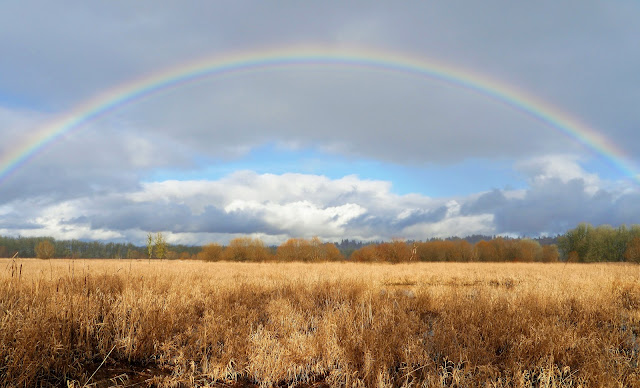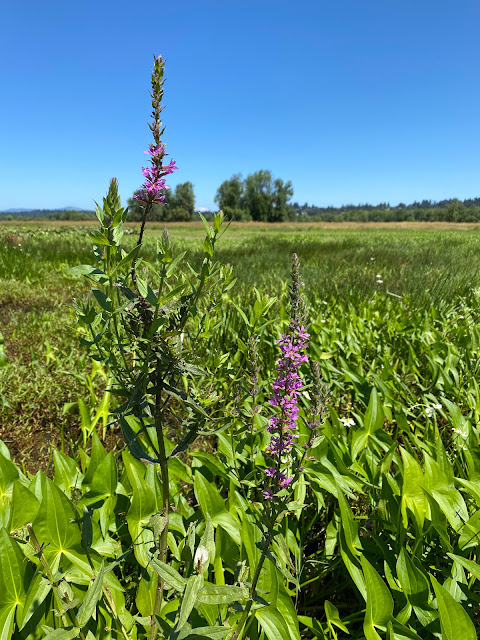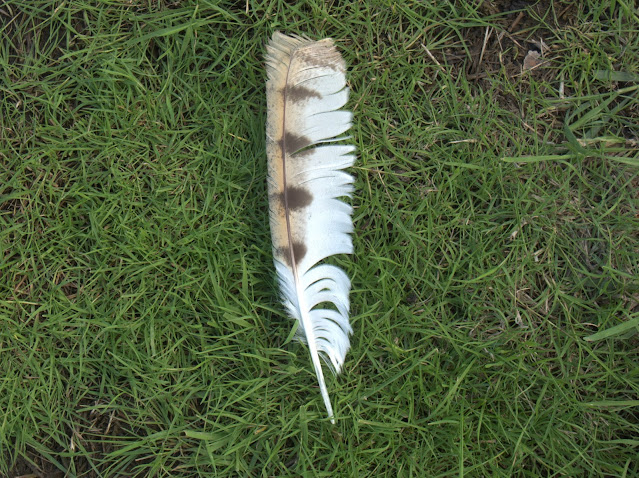Spring has officially sprung here at Ridgefield NWR! The Habitat Program is in full swing, and the pace of field work has really picked up. With the absence of freezing temperatures at night, we have started herbicide treatments on invasive plants such as Poison Hemlock, Shiny Geranium, Yellow Flag Iris, etc. On the days I am not spraying herbicide, I devote time to tending the high tunnel and planting maintenance around the auto-tour route. Here soon we will be starting invasive plant searches and surveys in certain wetlands to monitor invasive plant growth - particularly, Ricefield Bulrush.
I am approaching a full year of employment at Ridgefield NWR, and each time we enter into a new season, I am always baffled by the beauty that is brought about by the changing temperatures. Springtime at Ridgefield is no exception. Male birds are singing their songs at full blast in the hopes of obtaining a mate, the plants are in full bloom, and wild rabbits are running all over the place out at Bachelor Island. Please enjoy the following photos and project updates - that I hope will give you a taste of Ridgefield NWR in the Springtime!
 |
While driving through the auto-tour route after work one day in March, this massive rainbow appeared in all of it's beauty. I was so happy that I had the time to capture this photo of it. It was such a typical day for spring weather in Washington - sunny with moments of rain in between (and even some hail).
How is the High Tunnel? The high tunnel project is progressing quickly. The warmer temperatures of spring have encouraged the plants out of dormancy, and all the plants I have started in the high tunnel are growing leaves like crazy! Outside the high tunnel, in the raised bed we constructed, we have Common Camas coming in, which we sowed just last fall. Inside the high tunnel, we are currently propagating Red Osier Dogwood, Red-flowering Currant, Oregon Grape, Osoberry, Wild Rose, Douglas Spirea, and Black Cotton-wood. Not to mention the fact that we have a large variety of potted plants that are being stored outside the high tunnel as well. Some of these plants will be tended to until next planting season, at which time they will be transferred to the field. The remainder of the plants will stay in the high tunnel until they are 2 to 3 years old. Outside the high tunnel we have started some plantings that we received from Scholl's Native Plant Nursery (including Cascara, Ocean Spray, Pacific Dogwood and Bitter Cherry). These plants will serve as native plant stock for us to take cuttings from once they mature. |
 |
A black cottonwood cutting that has sprouted leaves and looks happy as can be. |
 |
A red-flowering currant cutting that has its leaves out and a flower in bloom! Unfortunately, as pretty as the flowers are, I cut most of them off in order to ensure that the cuttings devote energy to root growth instead of flower growth. The Critters are Lively! |
I have realized in my time here at the Refuge that each season brings about different crowds of wildlife. The warmer temperatures of spring allow the reptiles and amphibians to come out of their winter homes. Spring also marks nesting and mating season for so many of the wildlife that live here. Below are just a few photos of some of the animals I have been seeing lately.
 |
Washington State has fewer lizard species compared to surrounding states. Growing up, I only ever saw lizards in Eastern WA. To my surprise, I came upon this little fella at the Carty Unit just a couple of weeks ago. He is a Northern Alligator, and it was the first time I have ever seen a lizard around this area! His camouflage is pretty great, can you spot him? |
 |
Here we have a very round Savannah Sparrow singing his heart out! He put on quite the performance. The male song birds at the Refuge have been quite loud lately. |
 |
I am going to say that baby geese are some of the cutest little creatures I have ever seen. This is the first family of the season that I spotted!
*It is important to remember not to linger around nesting, and newly born animals. We want to do our best not to stress them out, or cause them any unnecessary anxiety. Feel free to take photos and pause for a moment, but please do not stop your vehicle for too long around such sensitive wildlife!* |
 |
After some research, I believe this bird is called a Greater Yellowleg. I initially thought it was some sort of snipe. He uses his long beak to probe for worms and bugs in the sediment. |
Work Parties at the Carty Unit are Picking Back up!
April marked the beginning of Thursday closures of the Oaks to Wetlands Trail at the Carty Unit. The purpose of these closures is to give our staff and volunteers an opportunity to spray noxious weeds with herbicide, and to provide time for us to complete essential trail and restoration work (such as blackberry removal, watering native plants, etc.). We are still limited in our ability to bring on new volunteers due to Covid, but with more and more individuals getting vaccinated, I am hopeful that we will be able to recruit new individuals soon!
 |
Elena Tinoco, Friends of Ridgefield NWR Volunteer Coordinator was removing blackberries out of this snowberry patch. She is posing with her trusty loppers!
*Note* Facemasks are required at work parties unless a 20 ft. distance is maintained between individuals. |
 |
Tom Finn, trusted Friends of Ridgefield NWR Habitat Volunteer, is also working away at removing blackberries from native snowberry plants.
Work parties & Thursday closures at the Carty Unit will continue throughout the entire summer and into the fall. |
*Notice*
Due to field work picking back up, I will be aiming to post once a month! Feel free to
email me if you have any questions related to blog postings or the habitat program!











Comments
Post a Comment